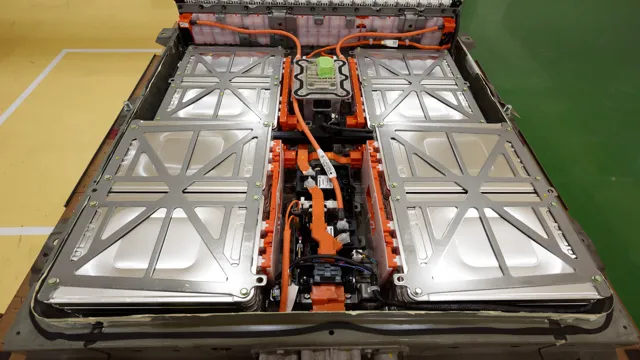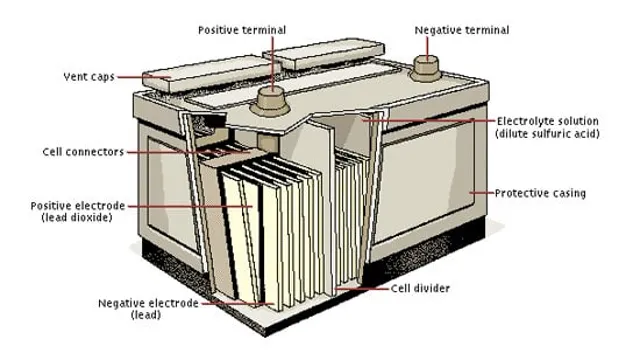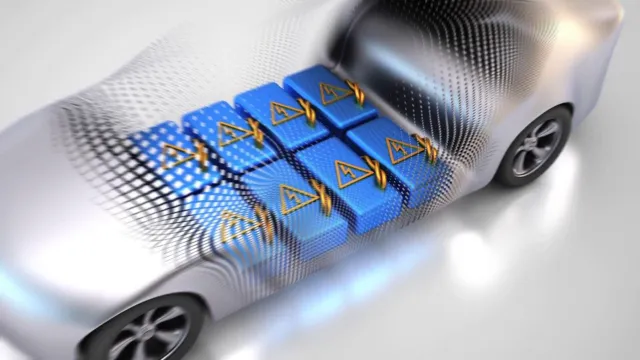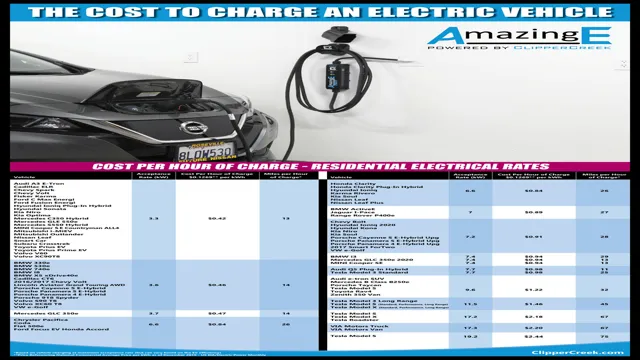Rev Up Your Battery Car: Discover the Ultimate Best Practices for Electric Vehicles
Electric cars are becoming increasingly popular as people are becoming more environmentally conscious and gas prices continue to rise. With this shift towards eco-friendly transportation, it is important to understand how to properly maintain the car’s battery. Electric car batteries are a crucial component of the vehicle, and proper care can extend their lifespan and efficiency.
In this blog post, we will explore the best practices for maintaining electric car batteries. From charging habits to temperature control and storage methods, we will cover everything you need to know to ensure your electric car battery is working at its best. So, let’s dive into the world of electric car batteries and learn how to keep them charged, healthy, and efficient for years to come.
Understanding Battery Chemistry
As electric cars grow in popularity, it’s important to understand the chemistry behind the battery that powers them. The most common type of battery used in electric cars is a lithium-ion battery, which consists of an anode, a cathode, and an electrolyte. The anode is typically made of graphite, while the cathode is made of a metal oxide, such as cobalt or nickel.
The electrolyte is a liquid or gel that acts as a conductor for the flow of ions between the anode and cathode. Understanding how these different components interact is key to optimizing battery performance and extending its lifespan. Best practices for maintaining your electric car’s battery include avoiding extreme temperatures and minimizing deep discharges, as well as following the manufacturer’s recommended charging practices.
By taking care of your electric car’s battery, you can help ensure that it operates at peak performance for years to come.
Lithium-ion vs Lead-Acid Batteries
Battery chemistry is essential in understanding the differences between Lithium-ion and Lead-Acid batteries. Lithium-ion batteries offer several advantages over their Lead-Acid counterparts, including a higher energy density, better power output, and longer lifespan. They are lightweight and have a lower self-discharge rate, making them ideal for portable devices and electric vehicles.
On the other hand, Lead-Acid batteries are less expensive and widely available. They are commonly used in automotive applications due to their ability to provide high amounts of power. In conclusion, the choice between Lithium-ion and Lead-Acid batteries depends on the specific requirements of the intended application.
Lithium-ion batteries are suitable for applications that prioritize energy density and longevity, while Lead-Acid batteries are best for those requiring high power output and affordability. Understanding battery chemistry is crucial in making informed decisions.

Factors Affecting Battery Life
Battery life is a primary concern for anyone who uses portable electronic devices. The longevity of a battery is essential for the smooth functioning of an electronic device. Understanding battery chemistry is key to making it last longer.
The batteries inside electronic devices contain chemicals that produce and transfer electrons, which creates a flow of electricity. The type of chemicals used in these batteries determines the battery life. For instance, lithium-ion batteries have a longer life span compared to alkaline batteries.
The chemical components of the battery, including the anode, cathode, and electrolyte, also play a role in determining its performance. Factors like temperature, usage patterns, and charging habits contribute to battery life. By understanding the chemical composition and factors impacting battery performance, you can take steps to increase your device’s battery life.
Charging Tips for Longer Battery Life
If you own an electric car, one of the most important things to remember is to properly charge your battery to ensure it has a long lifespan. One of the best practices for battery car electric charging is to avoid rapid charging frequently. Rapid charging puts extra strain on the battery and can cause it to wear out quickly.
Instead, opt for slower charging methods such as a level 2 charger or a home charging station. It’s also important to avoid overcharging your battery. Most electric cars today have technology built in to prevent this, but it’s still a good rule of thumb to unplug the charger once your battery reaches 80-90% charge.
By following these simple charging tips, you can help extend the life of your electric car’s battery and enjoy more time driving emission-free on the road.
Avoiding Overcharging
When it comes to maintaining your device’s battery life, overcharging can be a major issue. Luckily, by following a few key tips, you can easily avoid overcharging and keep your battery running strong for longer. First and foremost, make sure to unplug your device once it’s fully charged, rather than leaving it plugged in for prolonged periods of time.
Additionally, try to keep your device at a moderate temperature while it’s charging, as extreme heat or cold can also damage the battery. Finally, consider investing in a high-quality charger that’s designed to protect against overcharging and other potential issues. By taking these simple steps, you can help ensure that your battery lasts as long as possible, so you can stay connected and productive throughout the day.
Charging at Optimal Temperatures
Charging your device at optimal temperatures is key to maintaining a longer battery life. Most devices perform best when charged at room temperature, between 20°C to 25°C, as extreme temperatures can affect the battery’s lifespan. For instance, charging your device in direct sunlight or a hot environment can lead to battery damage and limit its effectiveness over time.
Similarly, charging your device in a freezing environment can also cause damage and reduce its overall performance. To prevent this, try to charge your devices in a cool, dry place and avoid leaving them in direct sunlight or in a location where they are exposed to extreme temperatures. By doing this, you can help extend the life of your battery and enjoy your device’s full potential for longer.
Utilizing Off-Peak Charging Hours
One of the best ways to ensure your electric vehicle battery lasts as long as possible is by utilizing off-peak charging hours. This means charging your car during the times when demand for electricity is low, such as overnight. Not only is it better for your battery, but it can also save you money on your electricity bill.
You can even set your car to charge during off-peak hours automatically. It’s worth doing a little research to find out when your utility company’s off-peak hours are, as they may differ depending on where you live. By taking advantage of off-peak charging, you’ll be extending the life of your battery and helping to alleviate strain on the power grid during peak hours.
It’s a win-win!
Driving Habits to Prolong Battery Life
If you want to get the most out of your electric car’s battery and prolong its life, there are a few driving habits you should adopt. First and foremost, avoid rapid acceleration and sudden braking, as these actions can drain the battery quickly and decrease its long-term durability. It’s also important to avoid excessive idling and using power-hungry features like your car’s air conditioning or sound system too frequently.
Instead, try to keep your driving smooth and steady, and use these features conservatively. Additionally, try to charge your car’s battery regularly, ideally before it drops below 20% charge. By following these best practices, you can help to ensure that your electric car’s battery lasts as long as possible, allowing you to enjoy all of the many benefits of electric driving for years to come.
Smooth Acceleration and Deceleration
Smooth Acceleration and Deceleration One effective way to prolong the battery life of your electric vehicle is by driving with smooth acceleration and deceleration habits. Sudden and frequent acceleration and deceleration can damage the battery in the long run and cause premature wear and tear on the tires. Opting for a smooth ride will not only conserve your battery power but also make your ride more comfortable and less stressful.
A simple way to achieve smooth acceleration and deceleration is by gradually pressing down on the accelerator pedal instead of flooring it. The same technique can be used while braking as well. Gradually slowing down instead of slamming on the brake can help conserve energy and prolong the life of your battery.
Additionally, using cruise control can help maintain a steady, gentle speed, which will help in reducing energy consumption and prevent you from overusing your battery. Next time you take your electric vehicle for a spin, keep in mind the impact your driving habits have on your vehicle’s battery life and make a conscious effort towards smooth acceleration and deceleration.
Minimizing Use of Cabin Comfort Features
As electric vehicles are becoming more accessible, it’s important to consider ways to increase their battery life and efficiency. One way to do this is by minimizing the use of cabin comfort features while driving. By turning off or reducing the use of air conditioning, heating, and other electrical features, you can decrease the strain on the battery and extend its life.
Additionally, consider adjusting your driving habits to be more energy-efficient, such as avoiding sudden accelerations and braking, maintaining a consistent speed, and coasting whenever possible. By incorporating these habits into your driving routine, you can help prolong your electric vehicle’s battery life and reduce the need for frequent recharging. So, the next time you hit the road in your EV, turn down the AC, take it easy with the accelerator, and give your battery the break it needs to keep running smoothly.
Maintenance Tips for Electric Car Batteries
Battery car electric best practices are essential for keeping your electric vehicle’s batteries in top condition. One of the most important things you can do is to avoid overcharging your batteries. This can not only reduce the overall battery lifespan but can also cause overheating and damage to your car’s electronics.
To prevent overcharging, it is recommended to charge your electric car when the battery level drops below 20%. Additionally, maintaining the optimal temperature range for your batteries is important. Extreme temperatures can affect the battery’s overall health and performance, so it is best to avoid exposing your car to hot or cold weather for extended periods of time.
Lastly, regularly checking and maintaining the voltage and water levels in your batteries can help prevent damage and extend their lifespan. Battery car electric best practices and proper maintenance are essential to the longevity and efficiency of your electric vehicle.
Regular Battery Inspections and Cleanings
Electric car batteries require proper maintenance to ensure their longevity and optimal performance. One crucial aspect of battery maintenance is regular inspections and cleanings. Conducting routine battery inspections will help identify any potential issues such as damage or leakage.
Similarly, cleaning the battery terminals is essential to prevent any build-up of dirt, debris, or corrosion, as these can impede the flow of electricity and impact the overall battery performance. Keeping the battery clean and well-maintained can also prevent potential safety hazards and extend the battery’s overall lifespan. So, make it a habit to inspect and clean your electric car battery at least every six months to ensure its smooth operation.
Your battery will thank you for it!
Replacing Faulty Battery Modules
Electric car batteries require maintenance to ensure they function at their best, and one crucial aspect is replacing faulty battery modules. These modules are the individual cells that make up the battery pack, and if one or more of them fails, it can weaken the entire system. Regular checks can indicate when replacement is necessary, as the battery performance may drop, or the car’s range may be limited.
By having a professional mechanic replace any faulty battery modules promptly, you can avoid further damage or safety concerns. In addition to replacing faulty modules, other maintenance tips for electric batteries include keeping them clean, avoiding extreme temperature changes, and charging them correctly and consistently. By taking care of your electric car battery, you can ensure it serves you well for years to come.
Conclusion
In conclusion, battery car electric best practices are crucial to ensuring optimum performance and longevity of your electric vehicle. From monitoring charging levels and avoiding extreme temperature conditions to driving efficiently and maintaining the battery properly, there are several steps you can take to maximize the full potential of your battery-powered ride. So, remember to stay charged, stay cool, and drive smart – and you’ll be on the road to electric vehicle success in no time!”
FAQs
What are some best practices for maintaining the battery life of an electric car?
Some best practices for maintaining the battery life of an electric car include avoiding charging to 100% every time, avoiding high heat or cold temperatures for storage, using regenerative braking, and avoiding rapid charging frequently.
What is the average lifespan of an electric car battery?
The average lifespan of an electric car battery is around 8-10 years, but it can vary depending on the usage and maintenance of the battery.
How do I know when it’s time to replace my electric car battery?
A decrease in the range of the electric car and noticeable power loss are the signs that indicate it’s time to replace the battery. Some cars have diagnostics that display the health of the battery.
Do all electric cars use the same type of battery technology?
No, different electric car manufacturers use different types of battery technology. Lithium-ion batteries are most commonly used, but some cars use other types of batteries like solid-state or nickel-metal hydride.





